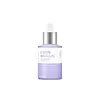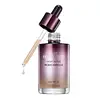What's inside
What's inside
 Key Ingredients
Key Ingredients

 Benefits
Benefits

 Concerns
Concerns

 Ingredients Side-by-side
Ingredients Side-by-side

Lactobacillus/Soybean Ferment Extract
Skin ConditioningBifida Ferment Lysate
Skin ConditioningLactobacillus Ferment Lysate
Skin ConditioningLactococcus Ferment Lysate
Skin ConditioningButylene Glycol
HumectantGlycerin
Humectant1,2-Hexanediol
Skin ConditioningMethyl Gluceth-10
EmulsifyingNiacinamide
SmoothingCitrus Aurantium Bergamia Fruit Oil
MaskingPogostemon Cablin Leaf Oil
MaskingCitrus Aurantium Dulcis Peel Oil
MaskingCentella Asiatica Leaf Extract
Skin ConditioningPolymnia Sonchifolia Root Juice
Skin ConditioningPanthenol
Skin ConditioningPolyglyceryl-10 Laurate
Skin ConditioningDiphenyl Dimethicone
EmollientTromethamine
BufferingTriethylhexanoin
MaskingWater
Skin ConditioningEthylhexylglycerin
Skin ConditioningAdenosine
Skin ConditioningHydrogenated Lecithin
EmulsifyingAlpha-Glucan Oligosaccharide
CleansingMadecassoside
AntioxidantAsiaticoside
AntioxidantMaltodextrin
AbsorbentTocopherol
AntioxidantLactobacillus
Skin ConditioningCarbomer
Emulsion StabilisingLimonene
PerfumingLinalool
PerfumingLactobacillus/Soybean Ferment Extract, Bifida Ferment Lysate, Lactobacillus Ferment Lysate, Lactococcus Ferment Lysate, Butylene Glycol, Glycerin, 1,2-Hexanediol, Methyl Gluceth-10, Niacinamide, Citrus Aurantium Bergamia Fruit Oil, Pogostemon Cablin Leaf Oil, Citrus Aurantium Dulcis Peel Oil, Centella Asiatica Leaf Extract, Polymnia Sonchifolia Root Juice, Panthenol, Polyglyceryl-10 Laurate, Diphenyl Dimethicone, Tromethamine, Triethylhexanoin, Water, Ethylhexylglycerin, Adenosine, Hydrogenated Lecithin, Alpha-Glucan Oligosaccharide, Madecassoside, Asiaticoside, Maltodextrin, Tocopherol, Lactobacillus, Carbomer, Limonene, Linalool
Water
Skin ConditioningBifida Ferment Lysate
Skin ConditioningGlycereth-26
HumectantSorbus Commixta Extract
Skin ConditioningJuniperus Chinensis Xylem Extract
Skin ConditioningBis-PEG-18 Methyl Ether Dimethyl Silane
EmollientButylene Glycol
HumectantGlycerin
HumectantNiacinamide
SmoothingLeuconostoc Ferment Filtrate
AntimicrobialBetaine
HumectantGrifola Frondosa/Ophioglossum Vulgatum Extract Ferment Filtrate
Skin ConditioningLactobacillus/Rice Ferment Filtrate
Skin ConditioningPortulaca Oleracea Extract
Skin ConditioningSodium Hyaluronate
HumectantAnthemis Nobilis Flower Extract
MaskingHydrolyzed Rice Extract
Skin ConditioningSea Water
HumectantCarthamus Tinctorius Oleosomes
EmollientHydrolyzed Extensin
Skin ConditioningAdenosine
Skin ConditioningDaucus Carota Sativa Root Extract
Skin ConditioningVaccinium Angustifolium Fruit Extract
Skin ProtectingBeta Vulgaris Root Extract
Skin ConditioningAronia Arbutifolia Extract
Skin ConditioningBrassica Oleracea Capitata Leaf Extract
Skin ConditioningEchium Plantagineum Seed Oil
Skin ConditioningAscorbyl Tetraisopalmitate
AntioxidantLactobacillus Ferment
Skin ConditioningLactococcus Ferment Lysate
Skin ConditioningManilkara Multinervis Leaf Extract
Skin ConditioningTheobroma Cacao Seed Extract
AntioxidantCassia Alata Leaf Extract
AstringentLaminaria Digitata Extract
Skin ProtectingSaccharomyces Ferment Filtrate
HumectantLactobacillus/Soybean Ferment Extract
Skin ConditioningSaccharomyces/Viscum Album Ferment Extract
Skin ConditioningYeast Ferment Extract
Skin ConditioningPogostemon Cablin Leaf Oil
MaskingPseudoalteromonas Ferment Extract
HumectantCardiospermum Halicacabum Flower/Leaf/Vine Extract
Skin ConditioningHelianthus Annuus Seed Oil Unsaponifiables
EmollientAlpha-Glucan Oligosaccharide
CleansingLimnanthes Alba Seed Oil
Skin ConditioningHydrolyzed Wheat Protein
Skin ConditioningBeta-Sitosterol
Emulsion StabilisingPanthenol
Skin ConditioningHydrolyzed Soy Protein
HumectantUbiquinone
AntioxidantMacadamia Ternifolia Seed Oil
EmollientRetinol
Skin ConditioningCucumis Melo Fruit Extract
Skin ConditioningBiotin
AntiseborrhoeicBrassica Campestris Sterols
EmollientSodium Ascorbyl Phosphate
AntioxidantAmaranthus Caudatus Seed Extract
Skin ConditioningTripeptide-10 Citrulline
Skin ConditioningAcetyl Hexapeptide-8
HumectantCopper Tripeptide-1
Skin ConditioningTripeptide-1
Skin ConditioningAcacia Arabica Stem Bark Extract
Skin ConditioningCholesterol
EmollientGlyceryl Linolenate
EmollientGlyceryl Linoleate
EmollientGlyceryl Arachidonate
EmollientCyclopentasiloxane
EmollientEthyl Hexanediol
SolventDimethicone
EmollientPEG-11 Methyl Ether Dimethicone
EmulsifyingPEG-40 Hydrogenated Castor Oil
EmulsifyingPPG-26-Buteth-26
Skin ConditioningPolysorbate 20
EmulsifyingCarbomer
Emulsion StabilisingGlyceryl Caprylate
EmollientTriethanolamine
BufferingDimethicone/Vinyl Dimethicone Crosspolymer
Skin ConditioningOctyldodecanol
EmollientXanthan Gum
EmulsifyingDipropylene Glycol
HumectantCyclomethicone
EmollientHydrogenated Lecithin
EmulsifyingDisodium EDTA
Dextrin
AbsorbentLauryl Methacrylate/Glycol Dimethacrylate Crosspolymer
Glyceryl Polyacrylate
Dimethiconol
EmollientPropylene Glycol
HumectantCeteth-24
CleansingCholeth-24
EmulsifyingHydroxypropyltrimonium Maltodextrin Crosspolymer
Cetyl Phosphate
EmulsifyingCaprylic/Capric Triglyceride
MaskingLecithin
EmollientPEG-5 Rapeseed Sterol
CleansingBHT
AntioxidantCeteth-3
EmulsifyingCeteth-5
EmulsifyingSilica
AbrasiveTocopheryl Acetate
AntioxidantPhenoxyethanol
PreservativeWater, Bifida Ferment Lysate, Glycereth-26, Sorbus Commixta Extract, Juniperus Chinensis Xylem Extract, Bis-PEG-18 Methyl Ether Dimethyl Silane, Butylene Glycol, Glycerin, Niacinamide, Leuconostoc Ferment Filtrate, Betaine, Grifola Frondosa/Ophioglossum Vulgatum Extract Ferment Filtrate, Lactobacillus/Rice Ferment Filtrate, Portulaca Oleracea Extract, Sodium Hyaluronate, Anthemis Nobilis Flower Extract, Hydrolyzed Rice Extract, Sea Water, Carthamus Tinctorius Oleosomes, Hydrolyzed Extensin, Adenosine, Daucus Carota Sativa Root Extract, Vaccinium Angustifolium Fruit Extract, Beta Vulgaris Root Extract, Aronia Arbutifolia Extract, Brassica Oleracea Capitata Leaf Extract, Echium Plantagineum Seed Oil, Ascorbyl Tetraisopalmitate, Lactobacillus Ferment, Lactococcus Ferment Lysate, Manilkara Multinervis Leaf Extract, Theobroma Cacao Seed Extract, Cassia Alata Leaf Extract, Laminaria Digitata Extract, Saccharomyces Ferment Filtrate, Lactobacillus/Soybean Ferment Extract, Saccharomyces/Viscum Album Ferment Extract, Yeast Ferment Extract, Pogostemon Cablin Leaf Oil, Pseudoalteromonas Ferment Extract, Cardiospermum Halicacabum Flower/Leaf/Vine Extract, Helianthus Annuus Seed Oil Unsaponifiables, Alpha-Glucan Oligosaccharide, Limnanthes Alba Seed Oil, Hydrolyzed Wheat Protein, Beta-Sitosterol, Panthenol, Hydrolyzed Soy Protein, Ubiquinone, Macadamia Ternifolia Seed Oil, Retinol, Cucumis Melo Fruit Extract, Biotin, Brassica Campestris Sterols, Sodium Ascorbyl Phosphate, Amaranthus Caudatus Seed Extract, Tripeptide-10 Citrulline, Acetyl Hexapeptide-8, Copper Tripeptide-1, Tripeptide-1, Acacia Arabica Stem Bark Extract, Cholesterol, Glyceryl Linolenate, Glyceryl Linoleate, Glyceryl Arachidonate, Cyclopentasiloxane, Ethyl Hexanediol, Dimethicone, PEG-11 Methyl Ether Dimethicone, PEG-40 Hydrogenated Castor Oil, PPG-26-Buteth-26, Polysorbate 20, Carbomer, Glyceryl Caprylate, Triethanolamine, Dimethicone/Vinyl Dimethicone Crosspolymer, Octyldodecanol, Xanthan Gum, Dipropylene Glycol, Cyclomethicone, Hydrogenated Lecithin, Disodium EDTA, Dextrin, Lauryl Methacrylate/Glycol Dimethacrylate Crosspolymer, Glyceryl Polyacrylate, Dimethiconol, Propylene Glycol, Ceteth-24, Choleth-24, Hydroxypropyltrimonium Maltodextrin Crosspolymer, Cetyl Phosphate, Caprylic/Capric Triglyceride, Lecithin, PEG-5 Rapeseed Sterol, BHT, Ceteth-3, Ceteth-5, Silica, Tocopheryl Acetate, Phenoxyethanol
 Reviews
Reviews

Alternatives
Ingredients Explained
These ingredients are found in both products.
Ingredients higher up in an ingredient list are typically present in a larger amount.
Adenosine is in every living organism. It is one of four components in nucleic acids that helps store our DNA.
Adenosine has many benefits when used. These benefits include hydrating the skin, smoothing skin, and reducing wrinkles. Once applied, adenosine increases collagen production. It also helps with improving firmness and tissue repair.
Studies have found adenosine may also help with wound healing.
In skincare products, Adenosine is usually derived from yeast.
Learn more about AdenosineAlpha-Glucan Oligosaccharide is a prebiotic. It prevents harmful bacteria from growing on skin by keeping the skin's microbiome in balance.
Another benefit of this ingredient is its antioxidant properties. Antioxidants protect our skin from oxidative damage.
Bifida Ferment Lysate is derived from the fermentation of Bifida bacteria (often with dairy). It is a probiotic and helps to strengthen our skin's microbiome.
Having a healthy microbiome helps protect our skin against infection. It also helps our skin stay hydrated and healthy.
Studies also show this ingredient to be a promising soothing ingredient for sensitive skin.
Learn more about Bifida Ferment LysateButylene Glycol (or BG) is used within cosmetic products for a few different reasons:
Overall, Butylene Glycol is a safe and well-rounded ingredient that works well with other ingredients.
Though this ingredient works well with most skin types, some people with sensitive skin may experience a reaction such as allergic rashes, closed comedones, or itchiness.
Learn more about Butylene GlycolCarbomer is a polymer of acrylic acid. Its main role is to create a gel consistency.
A high amount of carbomer can cause pilling or balling up of products. Don't worry, most products contain 1% or less of carbomer.
Glycerin is already naturally found in your skin. It helps moisturize and protect your skin.
A study from 2016 found glycerin to be more effective as a humectant than AHAs and hyaluronic acid.
As a humectant, it helps the skin stay hydrated by pulling moisture to your skin. The low molecular weight of glycerin allows it to pull moisture into the deeper layers of your skin.
Hydrated skin improves your skin barrier; Your skin barrier helps protect against irritants and bacteria.
Glycerin has also been found to have antimicrobial and antiviral properties. Due to these properties, glycerin is often used in wound and burn treatments.
In cosmetics, glycerin is usually derived from plants such as soybean or palm. However, it can also be sourced from animals, such as tallow or animal fat.
This ingredient is organic, colorless, odorless, and non-toxic.
Glycerin is the name for this ingredient in American English. British English uses Glycerol/Glycerine.
Learn more about GlycerinHydrogenated Lecithin is created from the hydrogenation of lecithin (a group of phospholipids). Hydrogenation is a chemical reaction between hydrogen and another element.
This ingredient is an emollient and emulsifier. As an emollient, it helps soften skin by trapping moisture within. As an emulsifier, it prevents oil and water ingredients from separating.
This ingredient is created by fermenting soybean extract with the bacteria, lactobacillus.
Some studies have shown it to have antioxidant properties. One study found this ingredient to have stronger properties than non-fermented soybean extract.
Another study found in increase of isoflavones, amino acids, and peptides in fermented soy milk.
Learn more about Lactobacillus/Soybean Ferment ExtractLactococcus Ferment Lysate is a postbiotic created by fermenting Lactoccus lactis, a type of bacteria more commonly used to create Lactic acid.
Postbiotics are inactive molecules produced by probiotic bacteria that provide skin benefits.
This ingredient offers promising benefits, but it is relatively new and more evidence is needed to prove its efficacy. The manufacturer claims this ingredient:
A study from 2022 found this ingredient helped protect skin against damaged from UV exposure (though this should not replace your sunscreen!).
The lysate in the ingredient name refers to a fluid that forms from breaking down the cell membrane.
Learn more about Lactococcus Ferment LysateNiacinamide is a multitasking form of vitamin B3 that strengthens the skin barrier, reduces pores and dark spots, regulates oil, and improves signs of aging.
And the best part? It's gentle and well-tolerated by most skin types, including sensitive and reactive skin.
You might have heard of "niacin flush", or the reddening of skin that causes itchiness. Niacinamide has not been found to cause this.
In very rare cases, some individuals may not be able to tolerate niacinamide at all or experience an allergic reaction to it.
If you are experiencing flaking, irritation, and dryness with this ingredient, be sure to double check all your products as this ingredient can be found in all categories of skincare.
When incorporating niacinamide into your routine, look out for concentration amounts. Typically, 5% niacinamide provides benefits such as fading dark spots. However, if you have sensitive skin, it is better to begin with a smaller concentration.
When you apply niacinamide to your skin, your body converts it into nicotinamide adenine dinucleotide (NAD). NAD is an essential coenzyme that is already found in your cells as "fuel" and powers countless biological processes.
In your skin, NAD helps repair cell damage, produce new healthy cells, support collagen production, strengthen the skin barrier, and fight environmental stressors (like UV and pollution).
Our natural NAD levels start to decline with age, leading to slower skin repair, visible aging, and a weaker skin barrier. By providing your skin niacinamide, you're recharging your skin's NAD levels. This leads to stronger, healthier, and younger looking skin.
Another name for vitamin B3 is nicotinamide. This vitamin is water-soluble and our bodies don't store it. We obtain Vitamin B3 from either food or skincare. Meat, fish, wheat, yeast, and leafy greens contain vitamin B3.
The type of niacinamide used in skincare is synthetically created.
Learn more about NiacinamidePanthenol is a common ingredient that helps hydrate and soothe the skin. It is found naturally in our skin and hair.
There are two forms of panthenol: D and L.
D-panthenol is also known as dexpanthenol. Most cosmetics use dexpanthenol or a mixture of D and L-panthenol.
Panthenol is famous due to its ability to go deeper into the skin's layers. Using this ingredient has numerous pros (and no cons):
Like hyaluronic acid, panthenol is a humectant. Humectants are able to bind and hold large amounts of water to keep skin hydrated.
This ingredient works well for wound healing. It works by increasing tissue in the wound and helps close open wounds.
Once oxidized, panthenol converts to pantothenic acid. Panthothenic acid is found in all living cells.
This ingredient is also referred to as pro-vitamin B5.
Learn more about PanthenolThis ingredient is commonly known as Patchouli oil.
Patchouli exhibits slight antibacterial and antifungal activity from its patchoulol and alpha-patchoulene content.
However, it also contains known skin-irritating fragrances. A study from 2015 found limonene and camphor as active components of this ingredient.
Limonene and camphor are both known EU allergens.
Learn more about Pogostemon Cablin Leaf OilWater. It's the most common cosmetic ingredient of all. You'll usually see it at the top of ingredient lists, meaning that it makes up the largest part of the product.
So why is it so popular? Water most often acts as a solvent - this means that it helps dissolve other ingredients into the formulation.
You'll also recognize water as that liquid we all need to stay alive. If you see this, drink a glass of water. Stay hydrated!
Learn more about Water